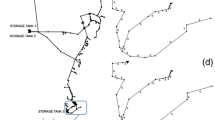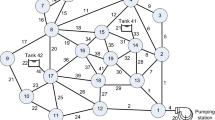Abstract
A methodology is presented for determining sustainability indices for pressure and water age in water distribution systems (WDSs). These sustainability indices are based upon performance criteria including reliability, resiliency, and vulnerability. Pressure and water age are determined for a WDS as a function of operation time using the U.S. Environmental Protection Agency EPANET model. The values of pressure and water age are used to determine reliability, resiliency, and vulnerability performance criteria, which are then combined into the nodal sustainability indices for water age and pressure. In addition, the sustainability index (SI) computations are performed for zones to define the SI for water age and SI for pressure. A combined SI calculation is performed to produce an overall sustainability score for the entire zone in the water distribution network. The proposed methodology can be used to monitor the sustainability of existing WDSs and to help define alternative solutions including changes in pump operation and modifications to WDS to increase the sustainability.


Similar content being viewed by others
References
American Water (2013) Energy & water. http://www.amwater.com/corporate-responsibility/corporate-responsibility-reporting/our-priority-your-water/energy-and-water.html Accessed 20 Jun 2014
AWWA (American Water Works Association), AWWARF (American Water Works Association Research Foundation) (1992) Water industry database: utility profiles. AWWA, Colorado
AWWA (American Water Works Association) (2002) Effects of water age on distribution system water quality. United States Environmental Protection Agency. Available online: http://www.epa.gov/ogwdw/disinfection/tcr/pdfs/whitepaper_tcr_waterdistribution.pdf Accessed 27 June 2014
Capón-García E, Espuña A, Puigjaner L (2009) Statistical and simulation tools for designing an optimal blanketing system of a multiple-tank facility. Chem Eng J 152:122–132
Chin DA (2000) Water resources engineering. Prentice-Hall, Upper Saddle River
Digiano FA, Weaver CC, Okun DA (2009) Benefits of shifting fire protection to reclaimed water. J Am Water Works Assoc 101(2):65–74
Furnass WR, Mounce SR, Boxall JB (2013) Linking distribution system water quality issues to possible causes via hydraulic pathways. Environ Model Softw 40:78–87
Giacomoni M.H. and Zechman E.M. (2011) Assessing sustainability of integrated urban water resources systems through a complex adaptive systems approach. World Environmental and Water Resources Congress, ASCE, 2844–2851
Giannetti BF, Bonilla SH, Silva CC, Almeida CM (2009) The reliability of experts’ opinions in constructing a composite environmental index: the case of ESI 2005. J Environ Manag 90(8):2448–2459
Gleick PH (2010) Roadmap for sustainable water resources in southwestern North America. Proc Natl Acad Sci USA 107(50):21300–21305
Goldman FE, Mays LW (2005) Water distribution system operation: application of simulated annealing. In: Mays LW (ed) Water resource systems management tools. McGraw Hill, New York
Gomez-Limona JA, Riesgo L (2009) Alternative approaches to the construction of a composite indicator of agricultural sustainability: an application to irrigated agriculture in the Duero basin in Spain. J Environ Manag 90(11):3345–3362
Great Lakes and Upper Mississippi River Board of State Public Health & Environmental Managers (GLUMB) (1992) Recommended standards for water works. Albany, New York
Hamouda MA, El-Din MMN, Moursy FI (2009) Vulnerability assessment of water resources systems in the Eastern Nile Basin. J Water Resour Manag 23:2697–2725
Hashimoto T, Stedinger JR, Loucks DP (1982) Reliability, resiliency and vulnerability criteria for water resource system performance evaluation. Water Resour Res 18(1):14–20
Herstein LM, Filion YR, Hall KR (2011) Evaluating the environmental impacts of water distribution systems by using EIO-LCA-Based multiobjective optimization. J Water Resour Plan Manag 137:162–172
Huizar L.H., Kang D., and Lansey K (2011) A decision support system for sustainable urban water supply. World Environmental and Water Resources Congress, ASCE, 3238–3250
Husband PS, Boxall JB (2011) Asset deterioration and discolouration in water distribution systems. Water Res 45(1):113–124
Jun L, Guoping Y (2013) Iterative methodology of pressure-dependent demand based on EPANET for pressure-deficient water distribution analysis. J Water Resour Plan Manag ASCE 139(1):34–44
Kay PA (2000) Measuring sustainability in Israel’s water system. Water Int 25(4):617–623
Kurek W, Ostfeld A (2013) Multi-objective optimization of water quality, pumps operation, and storage sizing of water distribution systems. J Environ Manag 115:189–197
Lamberton M., Newman D., Eden S. and Gelt J. (2010) The water-energy nexus. http://www.circleofblue.org/waternews/wp-content/uploads/2010/08/University-of-Arizona-water-energy-arroyo_2010.pdf Accessed 07 Mar 2013)
Li Y, Yang ZF (2011) Quantifying the sustainability of water use systems: calculating the balance between network efficiency and resilience. Ecol Model 222:1771–1780
Loucks DP (1997) Quantifying trends in system sustainability. Hydrol Sci J 42(4):513–530
Malczewski J (1999) GIS and multicriteria decision analysis. Wiley, New York
Mendez M, Araya JA, Sanchez LD (2013) Automated parameter optimization of a water distribution system. J Hydroinf 15(1):71–85
Ozger S, Mays LW (2005) Optimal location of isolation valves in water distribution systems: a reliability/optimization approach. In: Mays LW (ed) Water resource systems management tools. McGraw Hill, New York
Piratla KR, Ariaratnam ST (2012) Reliability based optimal design of water distribution networks considering life cycle components. Urban Water J 9(5):305–316
Rossman LA (2000) EPANET 2 users manual. U.S. Environmental Protection Agency, Cincinnati
Sandoval-Solis S, McKinney DC, Loucks DP (2011) Sustainability index for water resources planning and management. J Water Resour Plan Manag 137(5):381–390
Singh RK, Murty HR, Gupta SK, Dikshit AK (2012) An overview of sustainability assessment methodologies. Ecol Indic 15:281–299
Swamee PK, Sharma AK (2008) Design of water supply pipe networks. Wiley, Hoboken
Tabesh M, Dolatkhahi A (2006) Effects of pressure dependent analysis on quality performance assessment of water distribution networks. Iran J Sci Technol 30(B1):119–128
Tabesh M, Saber H (2012) A prioritization model for rehabilitation of water distribution networks using GIS. J Water Resour Manag 26:225–241
Tabesh M, Delavar MR, Delkhah A (2010) Use of geospatial information system based tool for renovation and rehabilitation of water distribution systems. Int J Environ Sci Technol 7(1):47–58
U.S. Army Corps of Engineers (1999) Design of small water systems. http://publications.usace.army.mil/publications/eng-manuals/EM_1110-2-503/EM_1110-2-503.pdf Accessed 25 Feb 2013
USEPA (United States of Environmental Protection Agency) (2002) Effects of water age on distribution system water quality. http://www.epa.gov/ogwdw/disinfection/tcr/pdfs/whitepaper_tcr_waterdistribution.pdf Accessed 07 Mar 2013
Yilmaz B, Harmancioglu NB (2010) An indicator based assessment for water resources management in Gediz River Basin, Turkey. J Water Resour Manag 24:4359–4379
Author information
Authors and Affiliations
Corresponding author
Rights and permissions
About this article
Cite this article
Aydin, N.Y., Mays, L. & Schmitt, T. Sustainability Assessment of Urban Water Distribution Systems. Water Resour Manage 28, 4373–4384 (2014). https://doi.org/10.1007/s11269-014-0757-1
Received:
Accepted:
Published:
Issue Date:
DOI: https://doi.org/10.1007/s11269-014-0757-1




